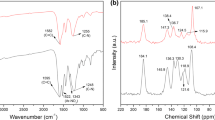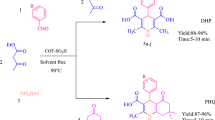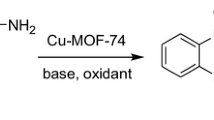Abstract
Imine-based covalent organic frameworks (COFs) with different functional groups have brought great application potentials in many fields, including heterogeneous catalysis. Herein, we report the synthesis of COFs containing carboxylic acid groups and their first application in the ruthenium-catalyzed synthesis of diarylmethane derivatives. Two new carboxyl-containing COFs (Tp-DAT and DHTA-DAT) have been prepared from 2,5-diaminoterephthalic acid and benzene-1,3,5-tricarbaldehyde derivatives with different numbers of hydroxy groups. Both Tp-DAT and DHTA-DAT COFs show high activity in the ruthenium-catalyzed ortho-C–H benzylation of 2-arylpyridines. Tp-DAT COF, which is fully linked by β-ketoenamine, has high stability, good yields and high chemoselectivity for ortho-benzylation and thus exhibits advantages in heterogeneous catalytic reactions.

摘要
含有不同官能团的亚胺基共价有机框架材料(COFs)在非均相催 化等领域具有很大的应用潜力. 本文合成了含羧基的COFs并将其首次 应用于钌催化合成二芳基甲烷衍生物. 以2,5-二氨基对苯二甲酸和含不 同羟基个数的苯-1,3,5-三醛衍生物为原料, 制备了两个新的含羧基 COFs (Tp-DAT和DHTA-DAT). Tp-DAT和DHTA-DAT COFs在钌催 化的2-芳基吡啶邻位苄基化反应中均表现出较高的活性. Tp-DAT COF 骨架完全由β-酮胺连接而成, 具有较高的稳定性, 使得邻位苄基化反应 获得更高的效率和化学选择性, 因此在非均相催化反应中更具优势.
Similar content being viewed by others
References
Ding SY, Wang W. Covalent organic frameworks (COFs): From design to applications. Chem Soc Rev, 2013, 42: 548–568
Waller PJ, Gándara F, Yaghi OM. Chemistry of covalent organic frameworks. Acc Chem Res, 2015, 48: 3053–3063
Huang N, Wang P, Jiang D. Covalent organic frameworks: A materials platform for structural and functional designs. Nat Rev Mater, 2016, 1: 16068
Diercks CS, Yaghi OM. The atom, the molecule, and the covalent organic framework. Science, 2017, 355: eaal1585
Beuerle F, Gole B. Covalent organic frameworks and cage compounds: Design and applications of polymeric and discrete organic scaffolds. Angew Chem Int Ed, 2018, 57: 4850–4878
Lohse MS, Bein T. Covalent organic frameworks: Structures, synthesis, and applications. Adv Funct Mater, 2018, 28: 1705553
Geng K, He T, Liu R, et al. Covalent organic frameworks: Design, synthesis, and functions. Chem Rev, 2020, 120: 8814–8933
Alahakoon SB, Diwakara SD, Thompson CM, et al. Supramolecular design in 2D covalent organic frameworks. Chem Soc Rev, 2020, 49: 1344–1356
Zeng Y, Zou R, Zhao Y. Covalent organic frameworks for CO2 capture. Adv Mater, 2016, 28: 2855–2873
Hu H, Yan Q, Ge R, et al. Covalent organic frameworks as heterogeneous catalysts. Chin J Catal, 2018, 39: 1167–1179
Kandambeth S, Dey K, Banerjee R. Covalent organic frameworks: Chemistry beyond the structure. J Am Chem Soc, 2019, 141: 1807–1822
Wang Z, Zhang S, Chen Y, et al. Covalent organic frameworks for separation applications. Chem Soc Rev, 2020, 49: 708–735
Haug WK, Moscarello EM, Wolfson ER, et al. The luminescent and photophysical properties of covalent organic frameworks. Chem Soc Rev, 2020, 49: 839–864
Sharma RK, Yadav P, Yadav M, et al. Recent development of covalent organic frameworks (COFs): Synthesis and catalytic (organic-electro-photo) applications. Mater Horiz, 2020, 7: 411–454
Guo ZC, Shi ZQ, Wang XY, et al. Proton conductive covalent organic frameworks. Coord Chem Rev, 2020, 422: 213465
Altaf A, Baig N, Sohail M, et al. Covalent organic frameworks: Advances in synthesis and applications. Mater Today Commun, 2021, 28: 102612
Tian G, Guo F, Fan C, et al. Recent advances in covalent organic frameworks-based heterogeneous catalysts for high-efficiency chemical transformation of carbon dioxide. J Solid State Chem, 2022, 316: 123614
Ma D, Wang Y, Liu A, et al. Covalent organic frameworks: Promising materials as heterogeneous catalysts for C-C bond formations. Catalysts, 2018, 8: 404
Zhi Y, Wang Z, Zhang HL, et al. Recent progress in metal-free covalent organic frameworks as heterogeneous catalysts. Small, 2020, 16: 2001070
Cheng HY, Wang T. Covalent organic frameworks in catalytic organic synthesis. Adv Synth Catal, 2021, 363: 144–193
Liu J, Wang N, Ma L. Recent advances in covalent organic frameworks for catalysis. Chem—An Asian J, 2020, 15: 338–351
Kandambeth S, Mallick A, Lukose B, et al. Construction of crystalline 2D covalent organic frameworks with remarkable chemical (acid/base) stability via a combined reversible and irreversible route. J Am Chem Soc, 2012, 134: 19524–19527
Kandambeth S, Venkatesh V, Shinde DB, et al. Self-templated chemically stable hollow spherical covalent organic framework. Nat Commun, 2015, 6: 6786
Li Y, Liu M, Wu J, et al. Highly stable β-ketoenamine-based covalent organic frameworks (COFs): Synthesis and optoelectrical applications. Front Optoelectron, 2022, 15: 38
Rej S, Das A, Chatani N. Strategic evolution in transition metal-catalyzed directed C-H bond activation and future directions. Coord Chem Rev, 2021, 431: 213683
Ankade SB, Shabade AB, Soni V, et al. Unactivated alkyl halides in transition-metal-catalyzed C-H bond alkylation. ACS Catal, 2021, 11: 3268–3292
Girard SA, Knauber T, Li CJ. The cross-dehydrogenative coupling of Csp3–H bonds: A versatile strategy for C–C bond formations. Angew Chem Int Ed, 2014, 53: 74–100
Bagdi AK, Rahman M, Bhattacherjee D, et al. Visible light promoted cross-dehydrogenative coupling: A decade update. Green Chem, 2020, 22: 6632–6681
Shang R, Ilies L, Nakamura E. Iron-catalyzed C–H bond activation. Chem Rev, 2017, 117: 9086–9139
Hu Y, Zhou B, Wang C. Inert C-H bond transformations enabled by organometallic manganese catalysis. Acc Chem Res, 2018, 51: 816–827
Duarah G, Kaishap PP, Begum T, et al. Recent advances in ruthenium(II)-catalyzed C-H bond activation and alkyne annulation reactions. Adv Synth Catal, 2019, 361: 654–672
Wu Y, Choy PY, Mao F, et al. Toluene derivatives as simple coupling precursors for cascade palladium-catalyzed oxidative C–H bond acylation of acetanilides. Chem Commun, 2013, 49: 689–691
Wu Y, Feng LJ, Lu X, et al. Palladium-catalyzed oxidative C–H bond acylation of N-nitrosoanilines with toluene derivatives: A traceless approach to synthesize N-alkyl-2-aminobenzophenones. Chem Commun, 2014, 50: 15352–15354
Li G, Li D, Zhang J, et al. Ligand-enabled regioselectivity in the oxidative cross-coupling of arenes with toluenes and cycloalkanes using ruthenium catalysts: Tuning the site-selectivity from the ortho to meta positions. ACS Catal, 2017, 7: 4138–4143
Schischko A, Ren H, Kaplaneris N, et al. Bioorthogonal diversification of peptides through selective ruthenium(II)-catalyzed C–H activation. Angew Chem Int Ed, 2017, 56: 1576–1580
Paterson AJ, Heron CJ, McMullin CL, et al. α-Halo carbonyls enable meta selective primary, secondary and tertiary C–H alkylations by ruthenium catalysis. Org Biomol Chem, 2017, 15: 5993–6000
Yuan C, Zhu L, Chen C, et al. Ruthenium(II)-enabled para-selective C–H difluoromethylation of anilides and their derivatives. Nat Commun, 2018, 9: 1189
Korvorapun K, Moselage M, Struwe J, et al. Regiodivergent C–H and decarboxylative C–C alkylation by ruthenium catalysis: Ortho versus meta position-selectivity. Angew Chem Int Ed, 2020, 59: 18795–18803
Wang H, Qian C, Liu J, et al. Integrating suitable linkage of covalent organic frameworks into covalently bridged inorganic/organic hybrids toward efficient photocatalysis. J Am Chem Soc, 2020, 142: 4862–4871
Zhao G, Mei Z, Duan L, et al. COF-based single Li+ solid electrolyte accelerates the ion diffusion and restrains dendrite growth in quasi-solid-state organic batteries. Carbon Energy, 2023, 5: e248
Dong B, Wang WJ, Xi SC, et al. A carboxyl-functionalized covalent organic framework synthesized in a deep eutectic solvent for dye adsorption. Chem Eur J, 2021, 27: 2692–2698
Pachfule P, Acharjya A, Roeser J, et al. Diacetylene functionalized covalent organic framework (COF) for photocatalytic hydrogen generation. J Am Chem Soc, 2018, 140: 1423–1427
Ming J, Liu A, Zhao J, et al. Hot π-electron tunneling of metal-insulator-COF nanostructures for efficient hydrogen production. Angew Chem Int Ed, 2019, 58: 18290–18294
Shan C, Zhu L, Qu LB, et al. Mechanistic view of Ru-catalyzed C–H bond activation and functionalization: Computational advances. Chem Soc Rev, 2018, 47: 7552–7576
Stegbauer L, Schwinghammer K, Lotsch BV. A hydrazone-based covalent organic framework for photocatalytic hydrogen production. Chem Sci, 2014, 5: 2789–2793
Zhang T, Ge Y, Wang X, et al. Polymeric ruthenium porphyrin-functionalized carbon nanotubes and graphene for levulinic ester transformations into γ-valerolactone and pyrrolidone derivatives. ACS Omega, 2017, 2: 3228–3240
Jiang W, Wang J, Jiang Y, et al. Multivalent ruthenium immobilized by self-supported NiFe-organic frameworks for efficient electrocatalytic overall water splitting. J Mater Chem A, 2023, 11: 2769–2779
Hu Y, Chen W, Ba M, et al. Solvent-free and highly efficient hydrogenation of α-pinene to synthesize cis-pinane by using Ru species immobilized on APTS-functionalized cubic phase NaNbO3. Catal Lett, 2019, 149: 180–189
Cheng Y, Zhang X, An G, et al. Visible-light-enabled ruthenium-catalyzed para-C–H difluoroalkylation of anilides. Chin Chem Lett, 2023, 34: 107625
Hofmann N, Ackermann L. meta-Selective C-H bond alkylation with secondary alkyl halides. J Am Chem Soc, 2013, 135: 5877–5884
Ackermann L, Hofmann N, Vicente R. Carboxylate-assisted ruthenium-catalyzed direct alkylations of ketimines. Org Lett, 2011, 13: 1875–1877
Acknowledgements
This work was supported by the National Natural Science Foundation of China (21372211).
Author information
Authors and Affiliations
Contributions
Author contributions Wang GW supervised the project. Wang N conceived the idea of this work. Wang N and Pan H carried out the experiments and performed detailed physical characterization. Wang N and Wang GW wrote the manuscript. All authors contributed to the discussion of the results and revision of the manuscript.
Corresponding author
Ethics declarations
Conflict of interest The authors declare that they have no conflict of interest.
Additional information
Supplementary information Experimental details and supporting data are available in the online version of the paper.
Nana Wang is a PhD student in the group of Professor Guan-Wu Wang at the Department of Chemistry, University of Science and Technology of China. Her research mainly focuses on COF-based materials and their applications in heterogeneous catalytic reactions.
Guan-Wu Wang obtained his PhD degree from the Department of Chemistry, Lanzhou University in 1993. After working as a postdoc in China and abroad, he joined the Department of Chemistry, University of Science and Technology of China as a full professor. His current research interests include organic chemistry and materials science.
Rights and permissions
About this article
Cite this article
Wang, N., Pan, H. & Wang, GW. Carboxyl-containing covalent organic frameworks: Synthesis and application in the ruthenium-catalyzed ortho-benzylation. Sci. China Mater. 66, 4689–4696 (2023). https://doi.org/10.1007/s40843-023-2625-7
Received:
Accepted:
Published:
Issue Date:
DOI: https://doi.org/10.1007/s40843-023-2625-7




